Looking for a meaningful, off-the-beaten-path experience in Japan? With Nagomi Visit, you can engage with authentic Japanese culture and everyday life by sharing a homemade meal in a local’s home. This guide will tell you exactly how to plan your Nagomi Visit.
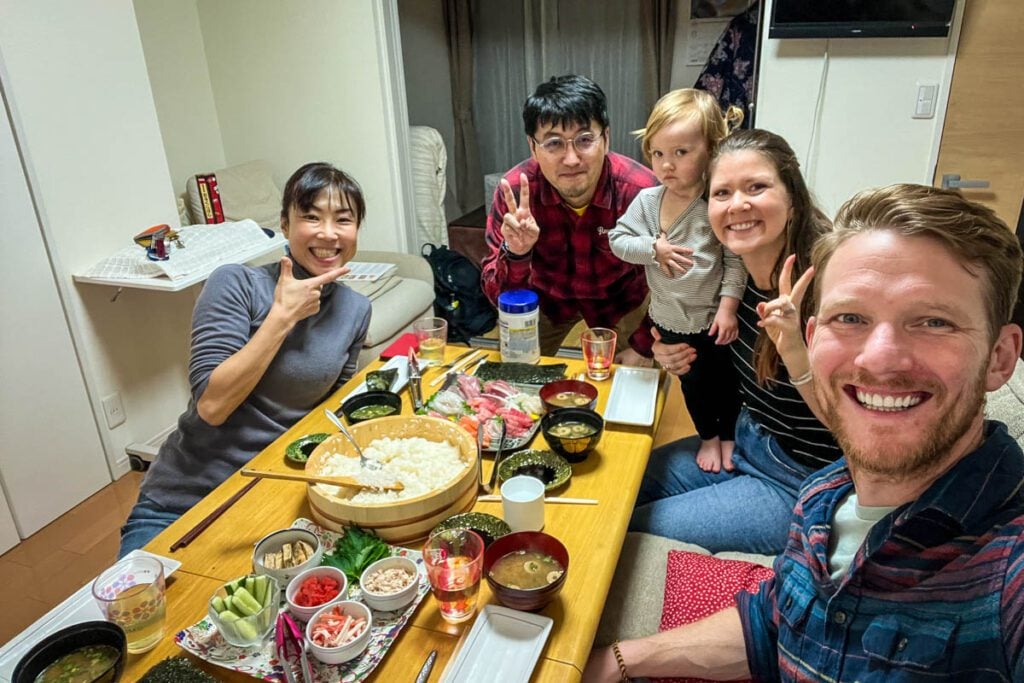
Ever wondered what it would be like to share a home-cooked meal with locals when traveling?
In Japan, you can do exactly that with an ingenious organization called Nagomi Visit.
Nagomi Visit is a really cool program that essentially pairs you with a local family with whom you can enjoy a homemade meal. In addition to great food, it’s also a unique opportunity to get a glimpse into authentic Japanese culture and daily life.
Plus, you’ll likely make some new friends by the end of the evening!
On one of our last nights in Tokyo, we went to a local couple’s home for dinner through the Nagomi Visit program, and it was absolutely one of the highlights of our trip. I wish this program existed in other countries too; I would love to do this in more places around the world!
If you’re a traveler who genuinely enjoys getting off the beaten path, this experience should definitely be on your Japan itinerary.
In this article, we’re going to share how Nagomi Visit works, as well as describe our personal experience.
Nagomi Visit Guide
Fun fact: Nagomi is a Japanese concept that reflects ease, contentment, emotional balance, and overall well-being. Japan’s reputation for health and longevity is often linked to this harmonious way of life.
How Nagomi Visit works

- Create a profile on the Nagomi Visit website, including a photo and description of who will be visiting.
- Create requests for each train station where you would be available to meet, as well as the dates you are free. You can choose either lunch or dinner.
- Good to know: This part can be a little time consuming since you need to start a new request for each train station.
- Families in those neighborhoods will see your request and can then respond with an invitation.
- Read through your invitations and each family’s profile to find one that you think is a match.
- ⚠️ Important: Invitations expire after 72 hours, so be sure to book and complete your payment before then.
- When you accept an invitation, you will receive meal options to choose from, as well as instructions about where to meet. You can determine a time that works for both parties.
- Make sure you communicate well with your host and arrive at the meeting place on time.
Our experience with Nagomi Visit
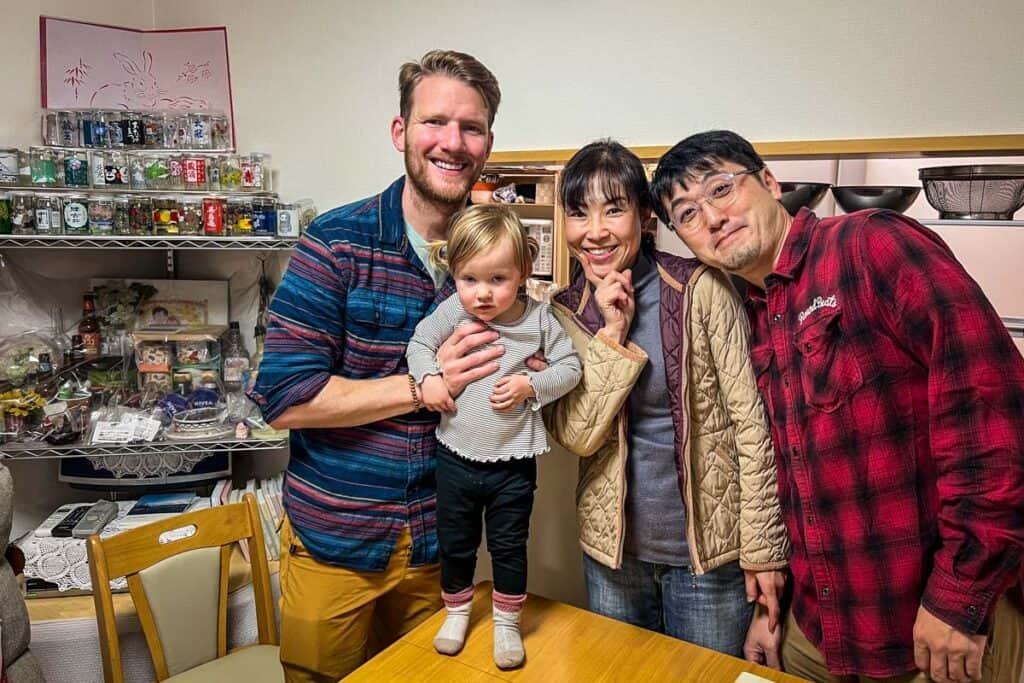
We had our first (but surely not our last!) experience with Nagomi Visit in Tokyo in 2023 and it was a highlight of our family trip to Japan.
We were hosted by the sweetest couple in Shimokitazawa, a Tokyo neighborhood we never would have discovered on our own that’s full of vintage shops, cozy restaurants, and buzzy izakayas. We already can’t wait to stay in this area next time we’re in Tokyo!
Our host couple, a news anchor and an engineer, both spoke English really well and were so welcoming. They adored our daughter, Juniper, and even gave her a teddy bear and some snacks to take home.
They gave us a tour of their home before we joined them in the kitchen to help prepare a delicious meal of temaki (hand roll sushi). Cooking together was such a fun way to break the ice and learn firsthand about Japanese cuisine.
Our visit lasted about 2-2.5 hours, which honestly flew by. We had great conversations, enjoyed some sake and ume (plum wine), and looked at photo albums of our hosts’ travels around Japan and their previous Nagomi Visit guests.
Tips for planning your Nagomi Visit
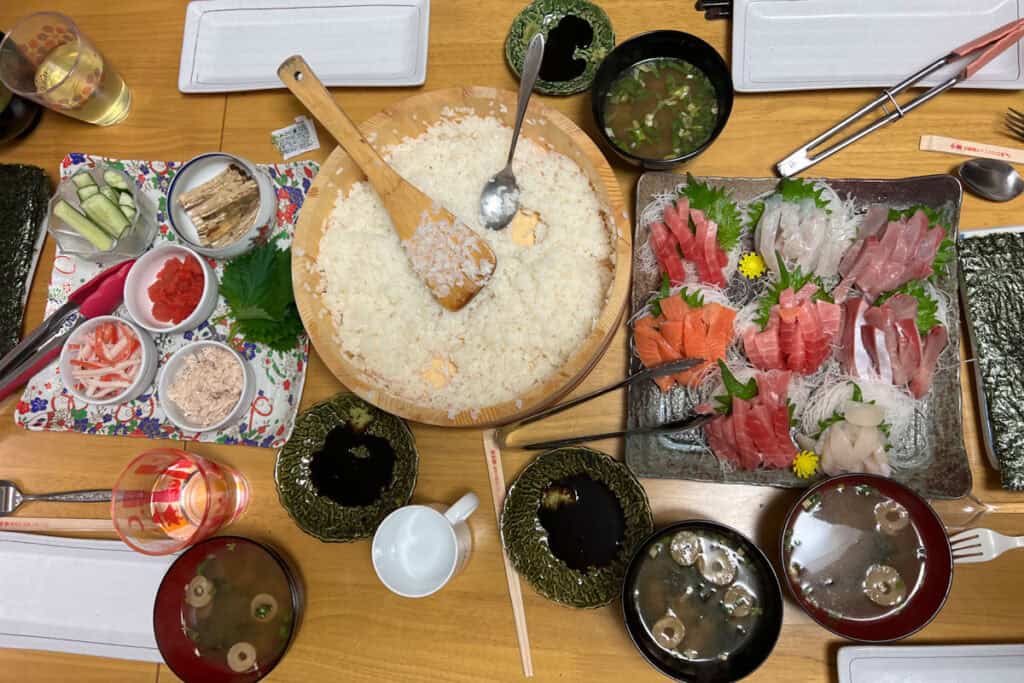
While we had an amazing experience with Nagomi Visit, there are a couple of things we could have done better in terms of planning—and we want to help you avoid making the same mistakes!
Here are some helpful tips and things we wish we’d known that will be useful as you plan your own visit:
1. Plan in advance
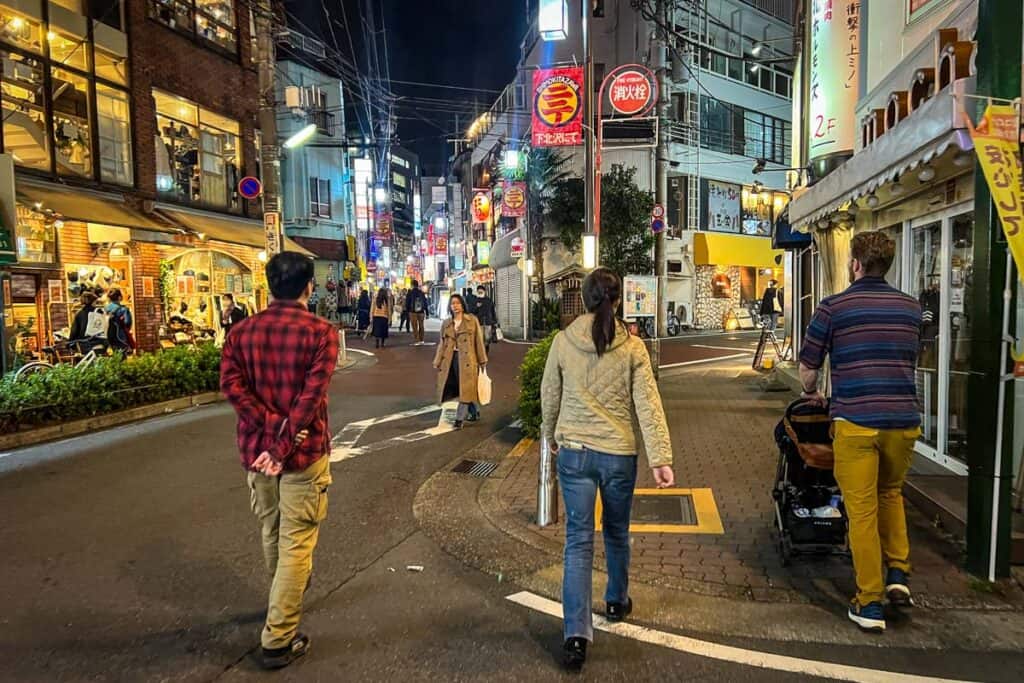
I’d recommend you submit your requests at least 3-4 weeks before your trip to have the best chance of finding a host for your dates and location. If you have dietary restrictions or other special requests, plan even further ahead to find available hosts who can accommodate you.
Personal experience:
I submitted our requests to Nagomi Visit just a couple of days before our trip. When we didn’t hear back from any hosts right away, I reached out to the organization and they told me hosts typically plan their schedules about 2 months in advance. We figured we’d missed our chance and were pretty bummed.
When we did finally hear back, we received only 2 invitations and had to shuffle around some of our itinerary to make it happen. It ended up working out pretty well for us and was 100% worth it, but planning further in advance would have given us more options to choose from.
Side note: Coincidentally, it happened that our visit was around American Thanksgiving. It was so special to get to have a homemade family dinner even though we were on the other side of the world!
→ Psst! Download our FREE Japan booking timeline to help keep your trip planning on track and ensure you don’t miss out on any bucket list experiences!
2. Be flexible
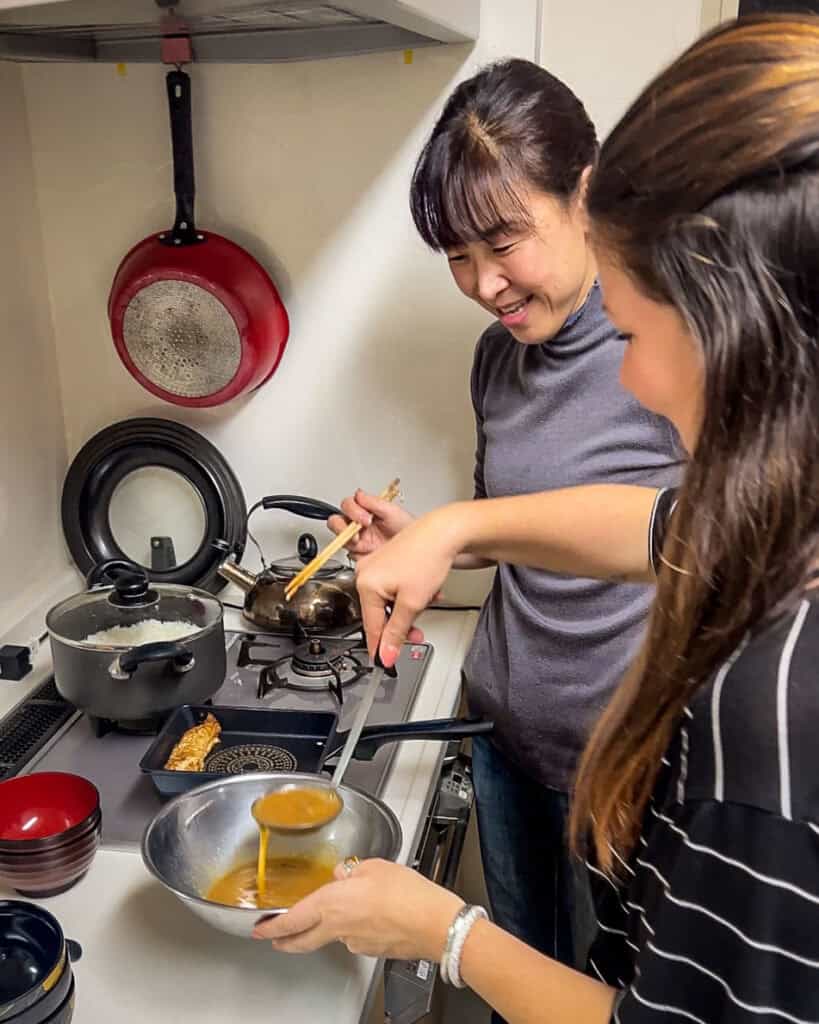
Providing a wide range of dates and times will increase your chances of receiving invitations, giving you more potential hosts to choose from. Including weekends helps, too, if it’s possible with your itinerary.
Insider tip: If you’re hoping to match with families who have children (this would be super fun if you’re traveling in Japan with kids!), consider Saturday lunch as an option.
It also helps to be open to different types of food. While some hosts may be able to accommodate certain dietary restrictions, you’ll likely have fewer options to choose from.
3. Chat with your host beforehand
Once you match with a host, you’ll be able to message each other through the Nagomi Visit platform. Your host might reach out to confirm details like allergies, food preferences, or directions.
Don’t be afraid to make the first move! Use this chance to ask any questions or just say a friendly hello. It helps break the ice and makes the dinner feel more like visiting friends than strangers.
Who knows—they might even have advice or recommendations for other things to do in the area!
4. Make sure you are reachable in Japan

You’ll want to make sure your host can contact you (and vice-versa) even after you’ve left your hotel. Since you’ll be communicating through the Nagomi Visit platform, all you need is mobile internet—and it’s easy to get!
The two most popular ways to stay connected in Japan are either with a WiFi hotspot device or an eSIM. Each has benefits, so we created a guide to choosing between a WiFi device and a SIM card that should help make this decision easier.
→ Psst! Don’t forget to pack a power bank so your phone doesn’t die!
5. Show up on time
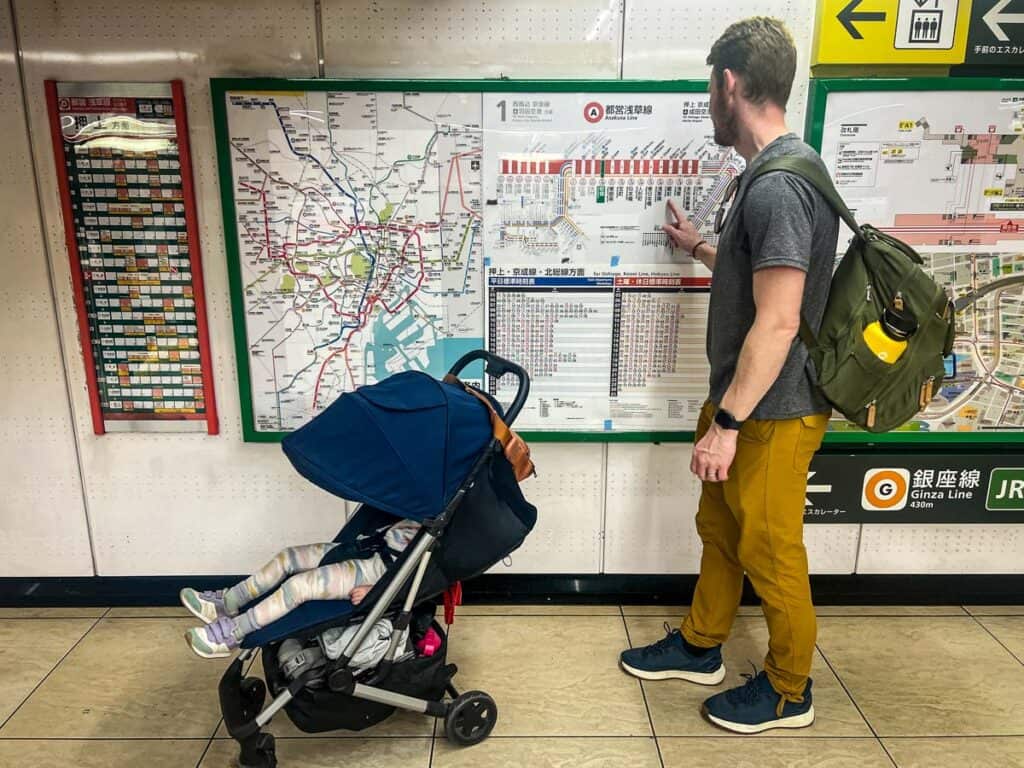
Punctuality is important in Japanese culture, and showing up late can come across as disrespectful.
Plan your route ahead of time and aim to arrive a few minutes early. If something unavoidable comes up, be sure to message your host as soon as possible to let them know.
6. Take off your shoes

If you’ve traveled in Japan before, you know the drill—take your shoes off as soon as you enter your host’s home.
They might offer you a pair of slippers to wear during your visit. Otherwise, a clean pair of socks will do the trick.
Hot tip! Ben and I each bought a pair of Kiziks before our most recent trip to Japan, and believe me when I say they are game-changers. They’re comfy, cute, and super easy to slip on and off (which you’ll be doing a lot in Japan).
7. Offer to help, but don’t be offended if they say no
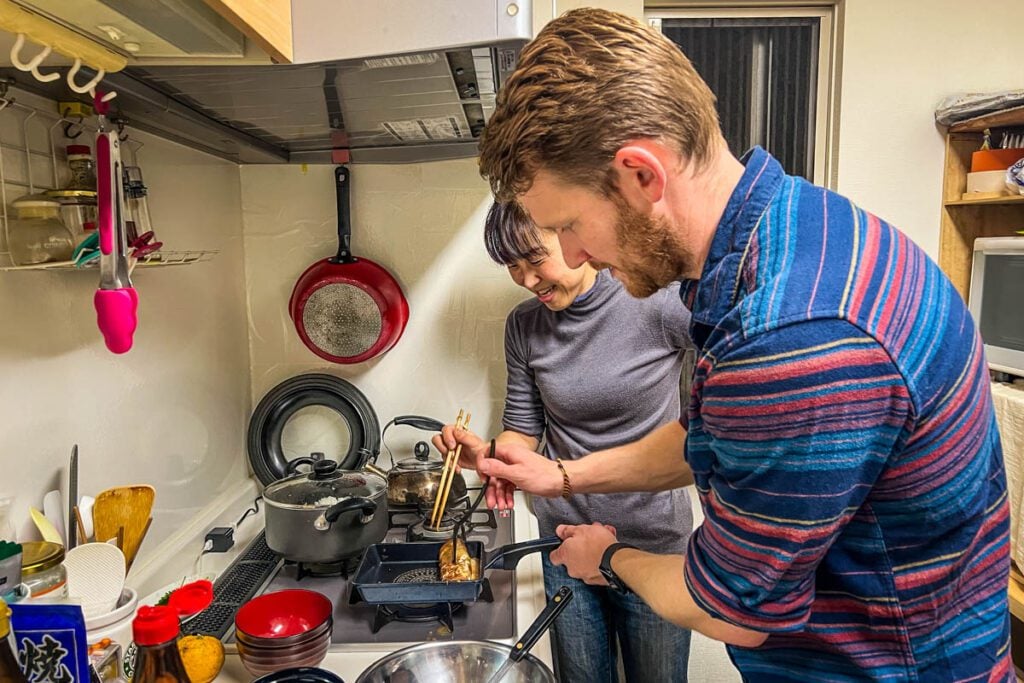
If you’re anything like us, you’ll probably automatically ask, “Can I help with anything?” while your host is preparing food.
Some hosts might politely decline because they see you as a guest, but chances are they won’t mind you watching or even pitching in.
We love taking cooking classes when we travel (we’ve done 3 in Japan alone!), so we really wanted to get involved. Our hosts were more than happy to share their expertise with us, and cooking together was such a fun experience!
7. Bring conversation starters
Your host wants to get to know you just as much as you want to learn about their life. You don’t need to bring anything special, just pull up a few photos on your phone of your hometown, family/friends, or other places you’ve traveled.
This is a great way to break the ice and share stories over dinner.
8. Brush up on Japanese etiquette
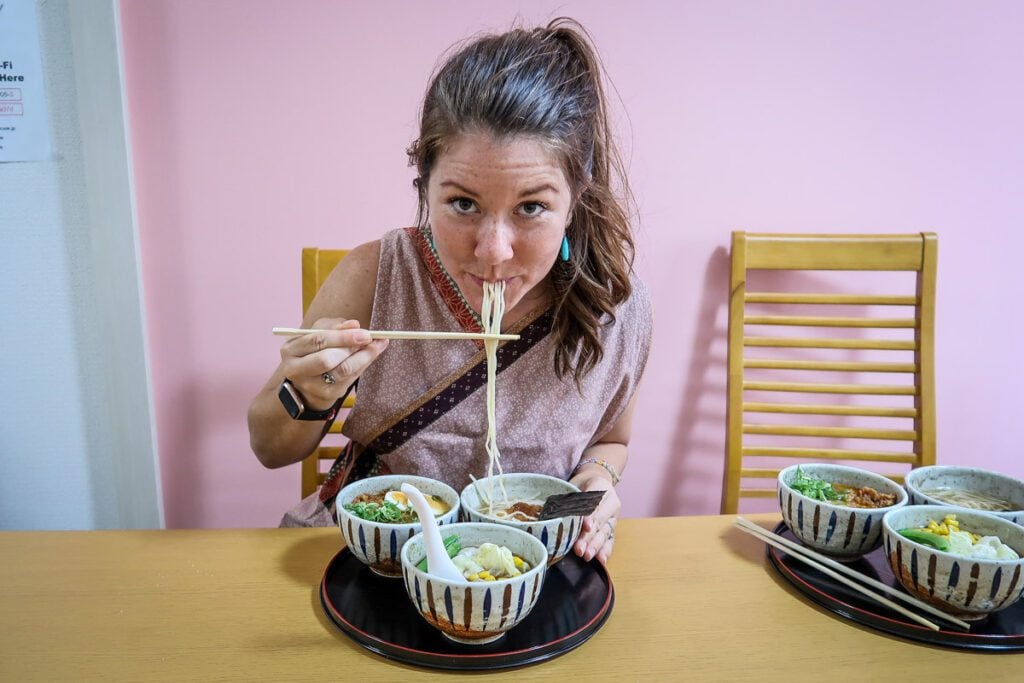
No one expects you to be an expert on Japanese table manners, but knowing a few basics shows respect for your host and their culture. Here are a few tips:
- Slurp those noodles! While considered rude in some Western countries, slurping in Japan is a sign that you’re enjoying your meal. It also helps cool down steaming noodles as you eat, so go ahead and slurp away!
- Follow proper chopstick etiquette. There are a few taboo things you should avoid doing with your chopsticks:
- Don’t leave your chopsticks inside a bowl sticking upright. This resembles a funeral ritual and is believed to bring bad luck.
- Don’t pass food from your chopsticks to someone else’s chopsticks.
- Don’t rest your chopsticks by crossing them on top of each other. Instead, place them side by side on the chopstick rest.
- Know what to do with communal plates. Some hosts might have serving utensils for family-style dining, while others might be okay with everyone using their own chopsticks. If you’re not sure, just ask!
→ We have a whole article on Japanese etiquette, including a section just for table manners. Check it out if you really want to wow your hosts!
Nagomi Visit FAQs
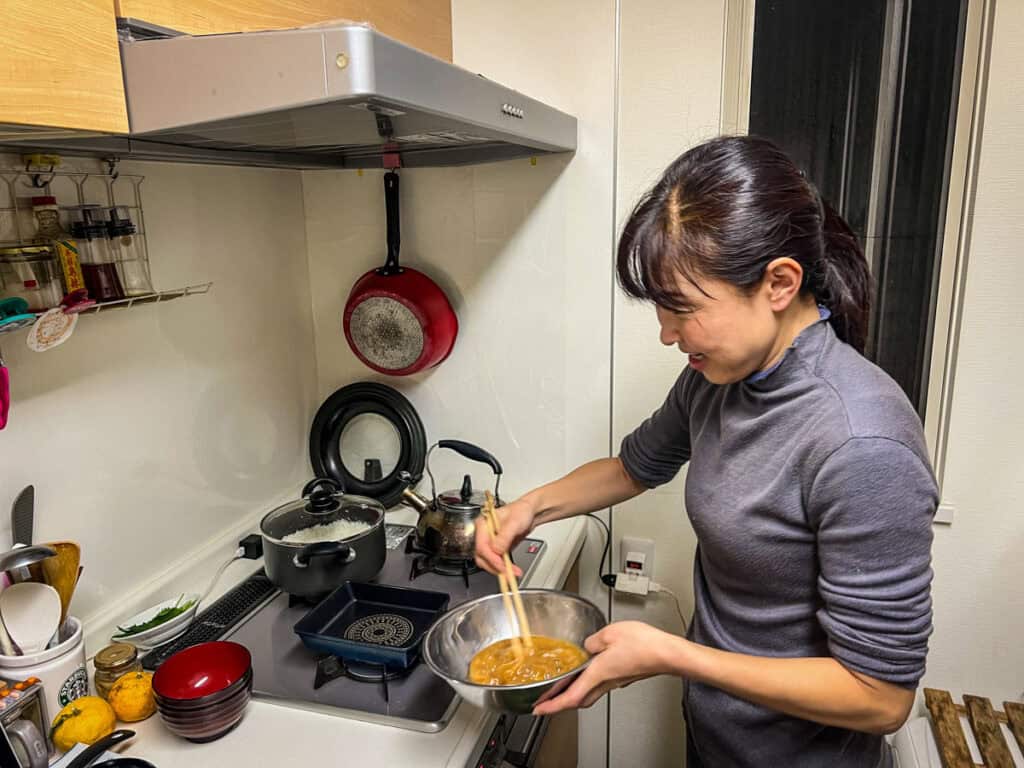
Let’s answer some common questions about Nagomi Visit that we haven’t covered yet in this article:
How much does it cost?
Here are the Nagomi Visit fees for 2025:
- ¥5,500 ($36) per adult
- ¥4,000 ($26) ages 5-12
- Free for children 4 and under
Note: Nagomi Visit only accepts credit card payment online; cash paid directly to hosts will not be accepted.
Can they accommodate dietary restrictions?
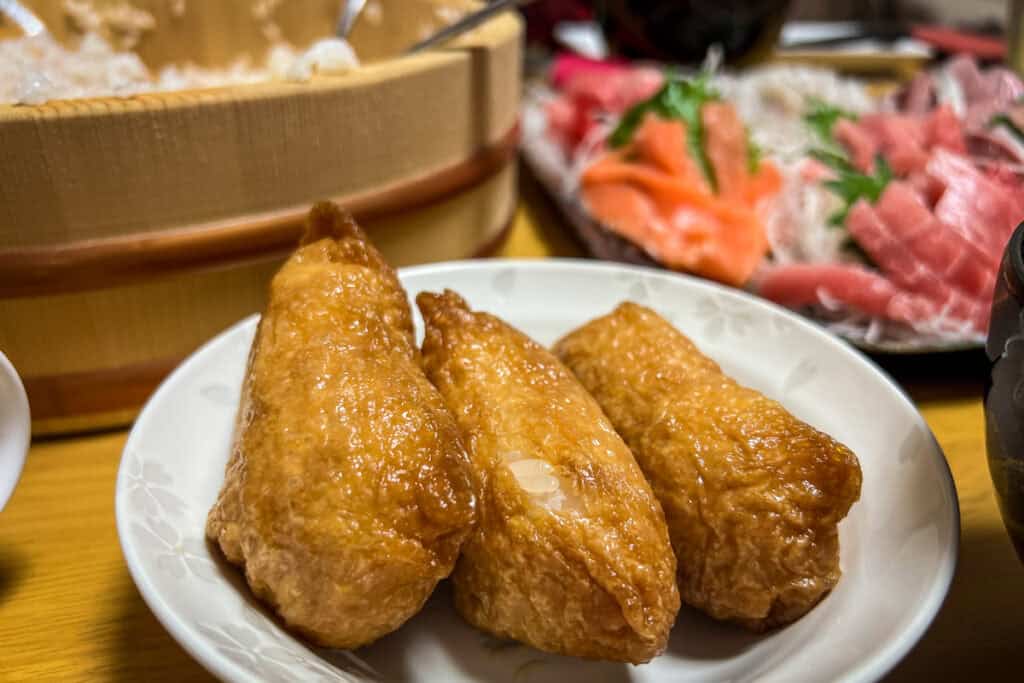
When you submit your requests, you’ll have the opportunity to specify if you have any allergies or dietary restrictions and Nagomi Visit will do their best to match you with hosts who can accommodate your needs.
That said, remember that your host is cooking your meal in their own home and may not be able to guarantee that there will be no cross-contamination.
Can you do this experience with children?

Absolutely! This is truly an experience for all ages.
We brought our then-2-year-old daughter for our Nagomi Visit and had the best time. Our hosts adored Juniper, played games with her, and even gave her a teddy bear and some snacks to take home.
Some host families also have children, and we think it would be super fun next time to visit a family with kids. Submitting your requests early and opening your availability to include Saturday lunch could help your chances of matching with families who have children.
Bonus: Nagomi Visit is FREE for children 4 and under!
→ Planning a family trip to Japan? We have an info-packed guide that covers all you need to know about traveling in Japan with kids, from what to pack to where to buy diapers (it’s not where you’d think to look!) and everything in between.
Where can you do Nagomi Visit?
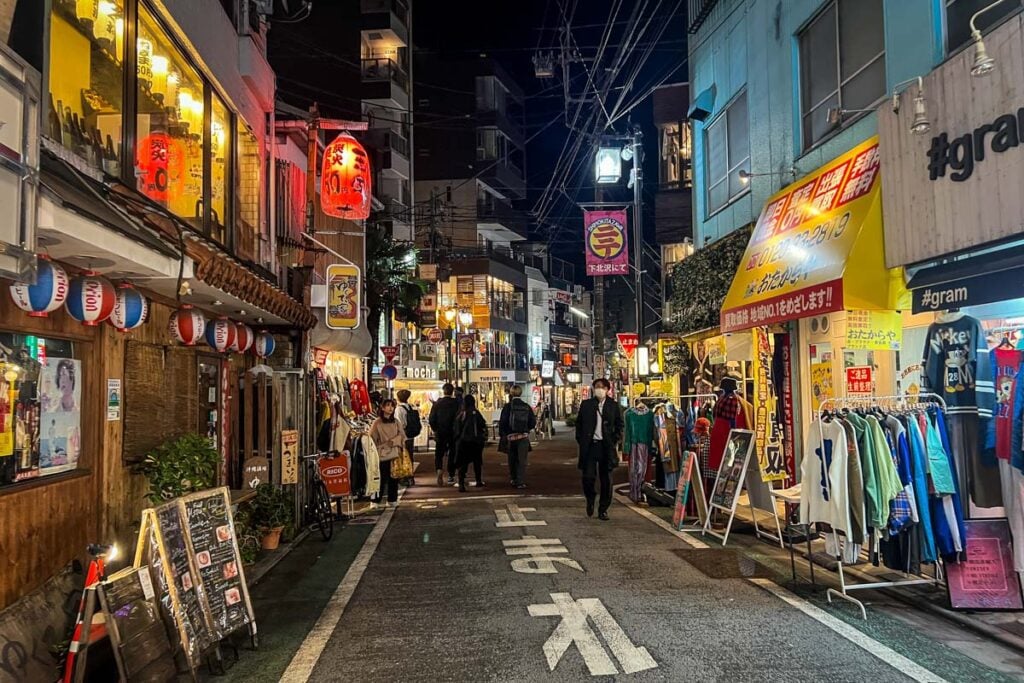
Nagomi Visit has hosts all over Japan, from Okinawa to Hokkaido.
Most are located in bigger cities like Tokyo, Kyoto, and Osaka, but there are also some hosts in more rural, off-the-beaten-path areas.
Should I bring anything?

You are not required or expected to bring anything for your Nagomi Visit.
That said, you might choose to bring some small items that represent your home country to give to people you meet in Japan. These gifts or souvenirs are known as omiyage and, while customary for Japanese people to pick up on their travels, are not expected from tourists.
Our experience: We’ve been to Japan 3 times and have personally never brought omiyage; however, we had such a wonderful evening connecting with our Nagomi Visit hosts and we would have loved to return their kindness with a small gift. There were also a couple of guest house hosts that were especially kind to our daughter who we would have liked to thank with a small gift, so we might bring omiyage on our next trip!
If you choose to bring omiyage, make sure they are small and don’t easily break. Here are a few ideas:
- Candy, snack, or food item from your home country (individually wrapped and non-perishable)
- Trader Joe’s spices or reusable bags (apparently these are a hot commodity in Japan!)
- Small magnet, pencil, pin, eraser that represents your home
Tip: If you want to bring a gift for your hosts but you didn’t pack any omiyage, check out their host profile to get ideas for something you can pick up in Japan.
Do I need to speak Japanese?
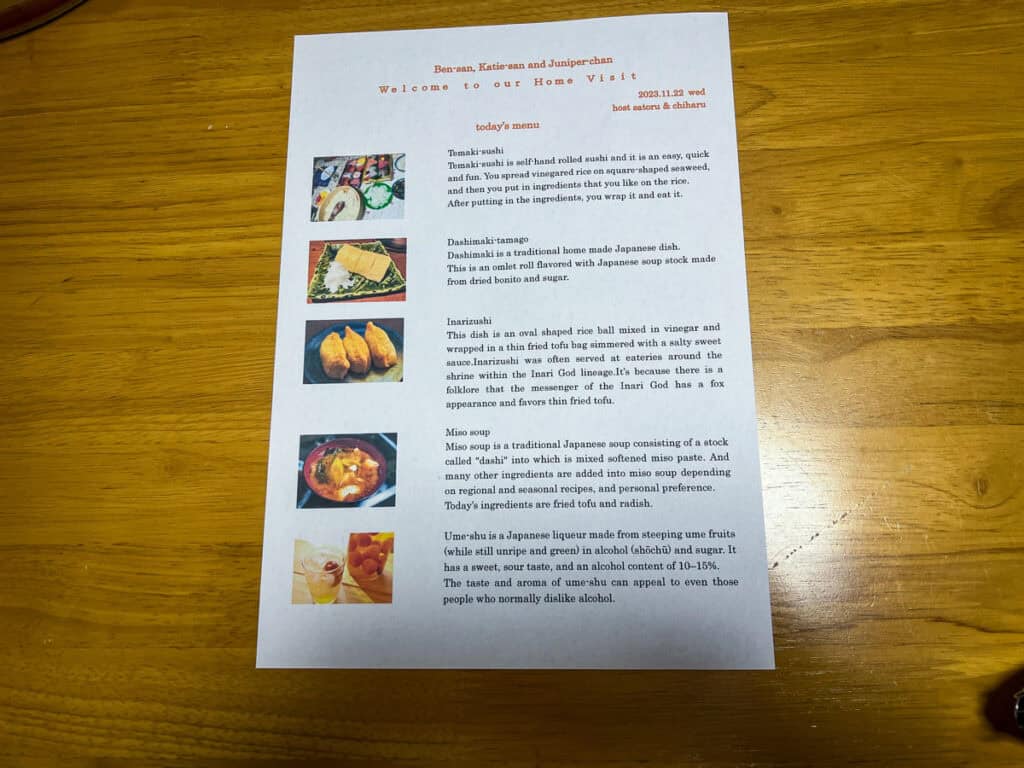
All Nagomi Visit hosts are prepared to speak English, so you don’t need to speak Japanese. Keep in mind that their fluency may vary and remember to be patient.
That said, learning a few simple Japanese phrases can be a great way to break the ice and show interest in the local culture.
In our experience, most locals appreciate when foreign visitors attempt to speak their language – even if your Japanese isn’t perfect (ours sure isn’t!).
Here are a few good phrases to try out during your Nagomi Visit:
- hajimemashite (hah-gee-may-mah-she-tay): nice to meet you
- itadakimasu (ee-tah-dah-key-mahss): thank you for the food
- Most Japanese people say this before eating to express gratitude for the meal and everything that went into creating it. Kind of like a non-secular way to say grace.
- gochiso-sama deshita (goh-chee-soh-sah-mah-day-shee-tah): thank you for the feast
- The counterpart to itadakimasu, this is said after a meal (when everyone is finished) to thank the cooks and let them know they’ve fed you enough.
- oishii (oy-she): delicious
For more useful phrases and communication tips, check out our Japanese language guide.
Plan your trip to Japan
After 3 trips (and counting!), we’ve fallen head over heels for Japan—and we’ve created TONS of resources to help you plan your dream trip. Start with our Ultimate Japan Travel Guide and be sure to check out these helpful articles:
- First time? Our Japan Trip Planner walks you through everything you need to know.
- Use our Japan Rail Pass guide to determine if getting a train pass is optimal for your trip.
- Here’s our curated list of the best things to do in Japan—from iconic sights to once-in-a-lifetime experiences.
- Not sure where to go? Our Japan itinerary ideas will help you map it all out.
- Foodies, rejoice! This guide to what to eat in Japan will have you drooling before you land.
- This guide to what to wear in Japan (and what not to wear) will help you blend in.
- Use our ultimate Japan Packing List to make sure you don’t forget anything.
- Before you go, brush up on these essential Japan travel tips (including major do’s and don’ts!).
- Avoid awkward moments by brushing up on Japanese etiquette.
Still have questions? Drop us a comment—we LOVE helping travelers plan unforgettable trips to Japan!
Perfect Japan itinerary
Want the perfect itinerary planned for you?

If you don’t have a ton of time to spend planning your Japan itinerary (or you just don’t find travel planning fun), we’ve got something you might be interested in…
We created the ultimate done-for-you Japan itinerary that is packed full of all sorts of tips we’ve gathered from 3 trips to Japan as well as literally hundreds of hours of research (no exaggeration).
We have both an off-the-beaten path route as well as a classic itinerary that hits the top attractions (perfect for your first visit to Japan!).
Don’t miss your chance to grab our Japan packing list!
This FREE PDF download includes everything you’re going to want to pack for your Japan trip, including what NOT to bring, plus tons of insider tips!
Just enter your email and we’ll immediately send you access instructions!
Save this article on Pinterest for later!

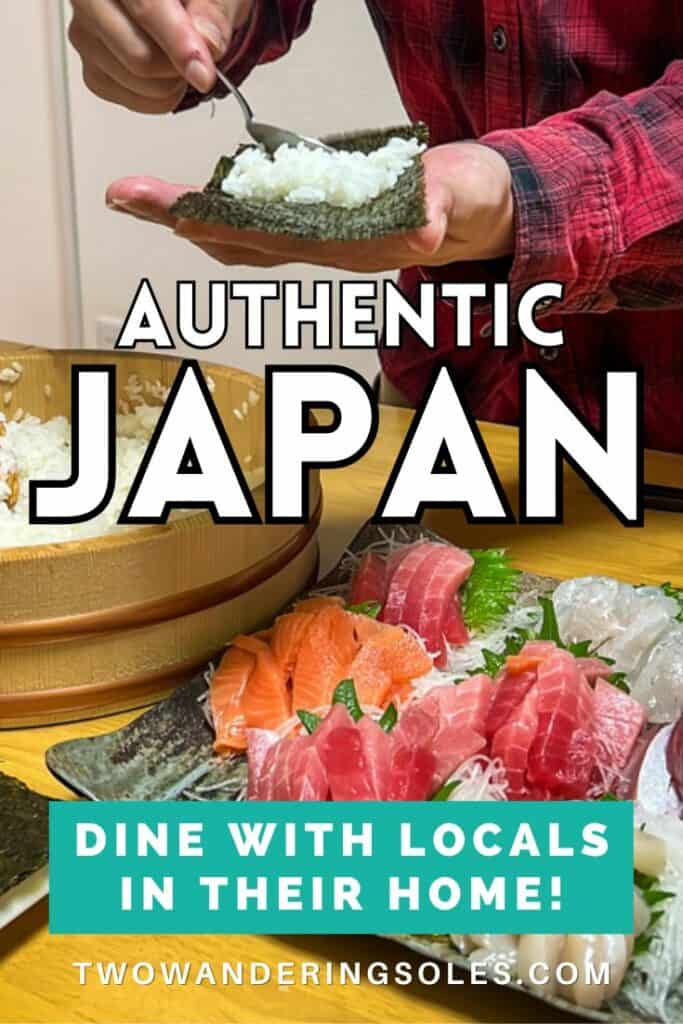
We want to hear from you!
Is having dinner with a local family in their home something you’d like to add to your Japan itinerary? Do you still have questions about Nagomi Visit after reading this article? Leave a comment below and we’ll do our best to get back to you!


